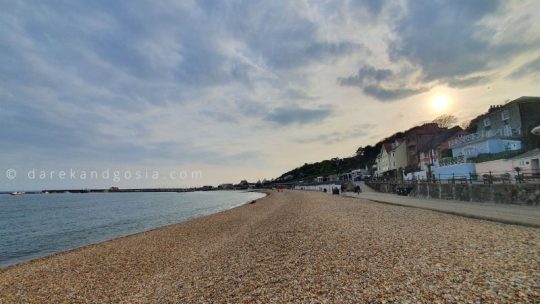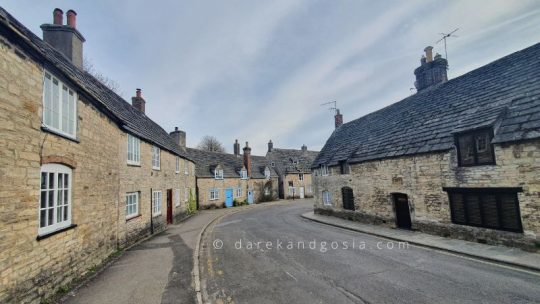Explore 95 miles of beautiful Jurassic Coast – from Old Harry Rocks in Dorset to Exmouth in Devon there are many unique places to see on the Jurassic Coast!
If you’re in the UK and want to see some of the most impressive coastal scenery in England, then the Jurassic Coast is where you should be.
The Jurassic coastline is truly a part of history. The area has been rated as a UNESCO World Heritage Site for its geological, biological and cultural value as well as for its role in the Industrial Revolution.
Why is the Jurassic Coastline famous?
The Jurassic Coast is the only place in the UK where you can walk along a continuous stretch of coastline that has been undisturbed for millions of years. This isn’t just a pretty sight either – it’s actually one of the most important geological sites in Europe. As such, it’s become a world heritage site and one of England’s most-visited places.
With a few famous British landmarks, the Jurassic Coast is a must-visit place in the South of England. If fact, it’s one of the most magical UK places and of one of our top destinations for a scenic drive!
How do I get to Jurassic Coast?
The Jurassic Coast stretches along the southern coast of England, from Exmouth in East Devon to Studland Bay in Dorset. Here are some ways to get to the Jurassic Coast:
- By Car: If you’re coming from London or the Midlands, you can take the M3, M27, and A31 to reach the Jurassic Coast. From Bristol, you can take the M5 to the A35, which runs along the coast. There are also many smaller roads and routes that offer scenic drives along the coast.
- By Train: The main railway stations on the Jurassic Coast are in Exeter, Weymouth, and Bournemouth. From London, you can take a train to Exeter or Weymouth, with journey times of around 2.5-3 hours. There are also train services from other major cities, including Bristol, Birmingham, and Manchester.
- By Bus: There are several bus services that run along the Jurassic Coast, including the Jurassic Coaster, which runs from Poole to Exeter, stopping at many towns and villages along the way. There are also bus services from major cities like Bristol and Plymouth.
Once you’re on the Jurassic Coast, there are many ways to explore, including walking, cycling, and driving. There are also many guided tours and boat trips available, which offer a unique perspective on the coastline.
Where is the best part of the Jurassic Coast?
The Jurassic Coast is a stretch of coastline in Dorset, England. It is one of the most iconic and beautiful places in Britain. The coastline is made up mainly of cliffs that rise up from the sea. The chalk cliffs, which were formed millions of years ago, have eroded over time and given way to some of the most stunning beaches you’ll ever see.
Where does the Jurassic Coast start and end?
The Jurassic Coast (or World Heritage Site) stretches from Old Harry Rocks in Dorset to Exmouth in Devon, including the towns of Lyme Regis and Weymouth.
The coastline is made up of cliffs, cliffs and more cliffs – but that’s no problem for the 2 million visitors who come here each year. There are plenty of attractions along this coastal road too, such as beaches, dunes, caves and beautiful coastal towns near London.
It doesn’t really matter where you start exploring the Jurassic Coast, whether your starting point is in Exmouth or from the area around Old Harry Rocks you still will have the opportunity to see some amazing places alongside the coast.
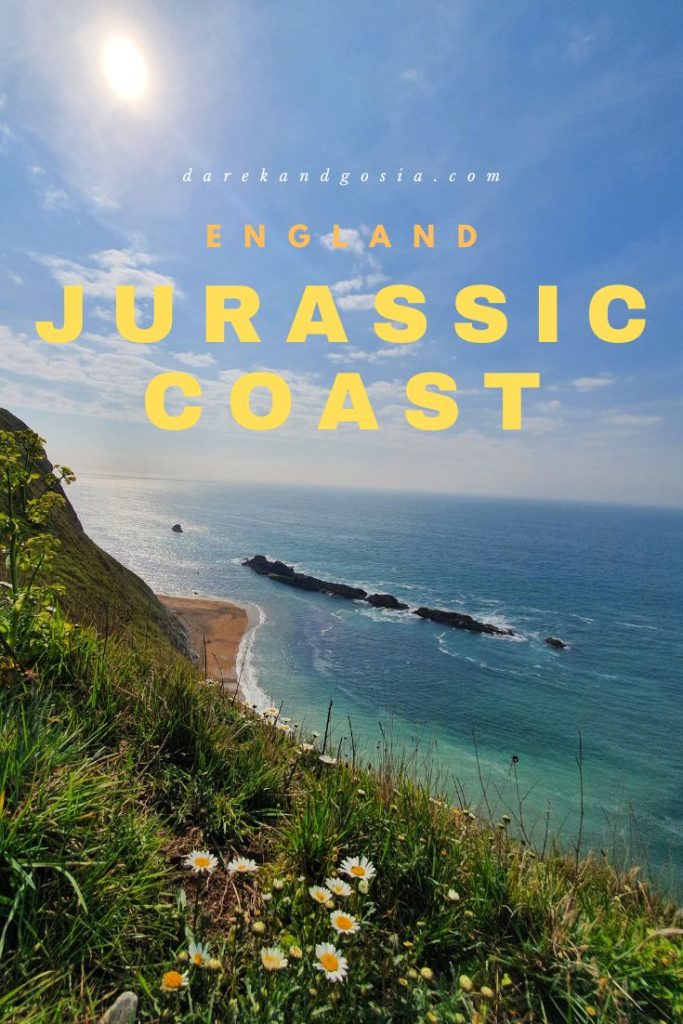
What to see on the Jurassic Coast?
The Jurassic coastline of England is one of the most stunning landscapes in the country, with a stretch of coast that rivals many European beaches. The area’s jaw-dropping cliffs, craggy rock formations and arches have been dubbed ‘Britain’s answer to California’.
If you’re planning a weekend trip to Europe but can’t quite commit to leaving your home country – or if you’d just like an excuse to visit our good old island nation – then this may be your answer. Jurassic Coast is always a great choice for a weekend away in the UK or a day trip from London.
Is Jurassic Coast good for a staycation or a UK weekend getaway?
Yes, the Jurassic Coast is a great destination for a staycation or a weekend getaway in the UK. The Jurassic Coast is a UNESCO World Heritage Site that spans 95 miles of coastline along the English Channel, stretching from Exmouth in East Devon to Studland Bay in Dorset. Here are some reasons why the Jurassic Coast is a stunning destination for a UK break:
- Stunning natural beauty: The Jurassic Coast is home to some of the most beautiful scenery in the UK, including dramatic cliffs, hidden coves, and idyllic beaches. Whether you’re looking to take a scenic walk or simply relax and soak up the views, the Jurassic Coast has plenty to offer.
- Rich history and culture: The Jurassic Coast is also home to a wealth of history and culture, including prehistoric fossils, ancient ruins, and quaint fishing villages. Visitors can explore charming towns like Lyme Regis and Weymouth, or delve into the fascinating world of dinosaurs at the Jurassic Coast’s many museums and visitor centers.
- Outdoor activities: The Jurassic Coast is a paradise for outdoor enthusiasts, with plenty of opportunities for hiking, cycling, kayaking, and more. There are also plenty of outdoor adventure activities available, including coasteering, rock climbing, and surfing.
- Great food and drink: The Jurassic Coast is home to a thriving food and drink scene, with plenty of restaurants, cafes, and pubs serving up delicious local produce. Visitors can sample fresh seafood, local cheeses, and craft beers, or visit one of the region’s many vineyards to try some of the area’s award-winning wines.
Overall, whether you’re looking for a relaxing beach break or an action-packed outdoor adventure, the Jurassic Coast has something for everyone and is a top UK destination for a staycation or weekend getaway in the UK.
Jurassic Coast places to visit (Dorset)
1. Old Harry Rocks
Things to do on the Jurassic Coast? Old Harry Rocks are a majestic and dramatic set of sea stacks on the Jurassic Coast near Swanage, Dorset, England.
Old Harry Rocks is one of the most popular locations on the Jurassic Coast World Heritage Site, but it can get very crowded at peak times so we recommend visiting early or late in the day to avoid crowds and allow plenty of time to explore.
There is no better way to start exploring the Jurassic Coast than visiting Old Harry Rocks!
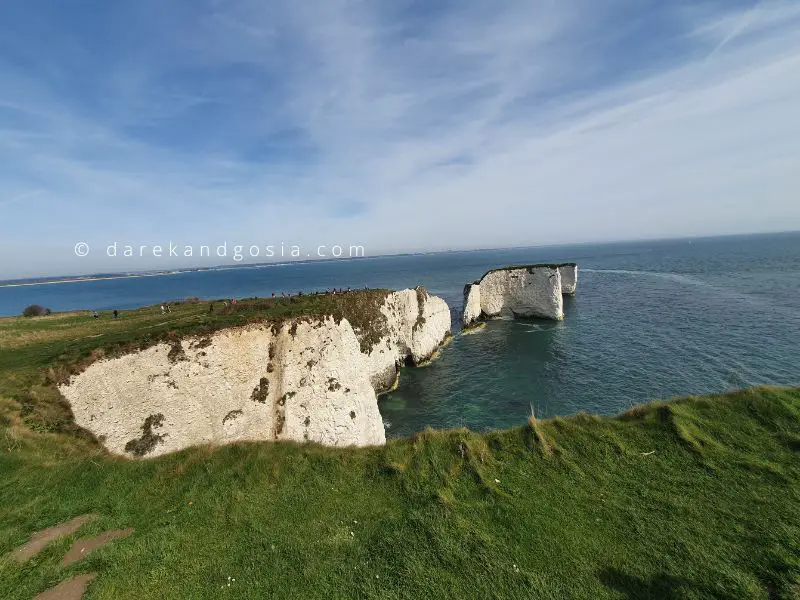
2. Studland
Places to visit on the Jurassic Coast? Studland is one of the best places to see the Jurassic Coast and is a great place to explore all year round.
The area is famous for its fossils, which can be found along the beach and in the surrounding cliffs. The beach itself is a beautiful sandy beach which faces south-east towards the Isle of Wight, making it a popular place for swimming and sunbathing.
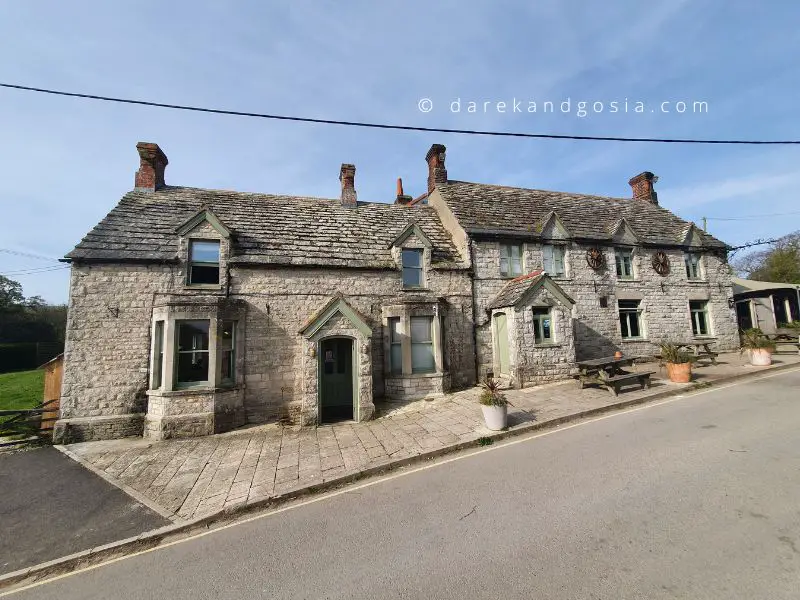
3. Swanage
What to do on the Jurassic Coast? Swanage is a small town on the south coast of England, in the county of Dorset. It lies at the western end of the Isle of Purbeck, a peninsula to the south-west of London. Swanage has a population of around 10,000, measured at 9,720 in the 2011 census. It is bordered by Corfe Castle to the east and Langton Matravers to the west.
The town’s focal point is The Square which serves as its main thoroughfare and shopping area. Swanage Pier was opened in 1859 by Queen Victoria and is one of only four piers on the south coast still operating today.
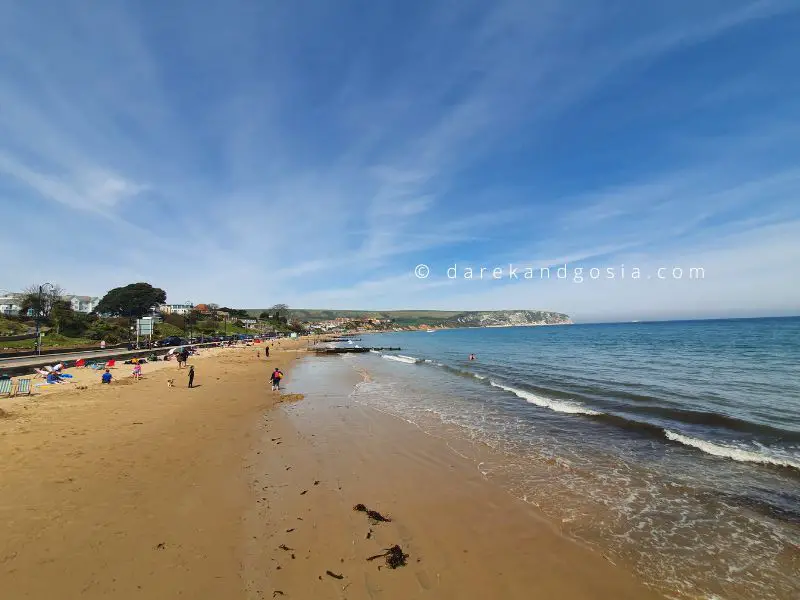
4. Corfe Castle
Unique things to do on the Jurassic Coast? Corfe Castle is a castle in the village of Corfe in the English county of Dorset. It was built in 1067 by William the Conqueror on the site of an earlier Saxon fortification. The first phase was one of the earliest castles in England to be built at least partly using stone when the majority were built with earth and timber.
Fun fact: Corfe Castle has been used as a location for several films and television programmes; most famously its usage as Wayne Manor in Batman Begins and The Dark Knight Rises, where it doubled for Arkham Asylum.
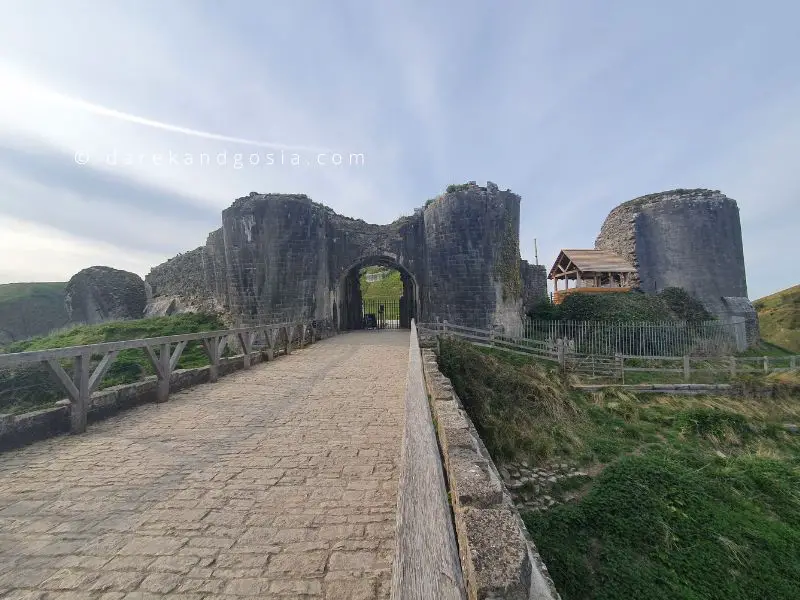
5. The Blue Pool
Best things to do on the Jurassic Coast? The Blue Pool gets its name from the colour of its water, which can vary depending on the time of year and level of rainfall. The colour can be due to several factors like the presence of algae and the presence of minerals dissolved from surrounding rocks.
It was originally called “The Blue Lagoon”, but has since been renamed “The Blue Pool” to avoid confusion with other blue lagoons.
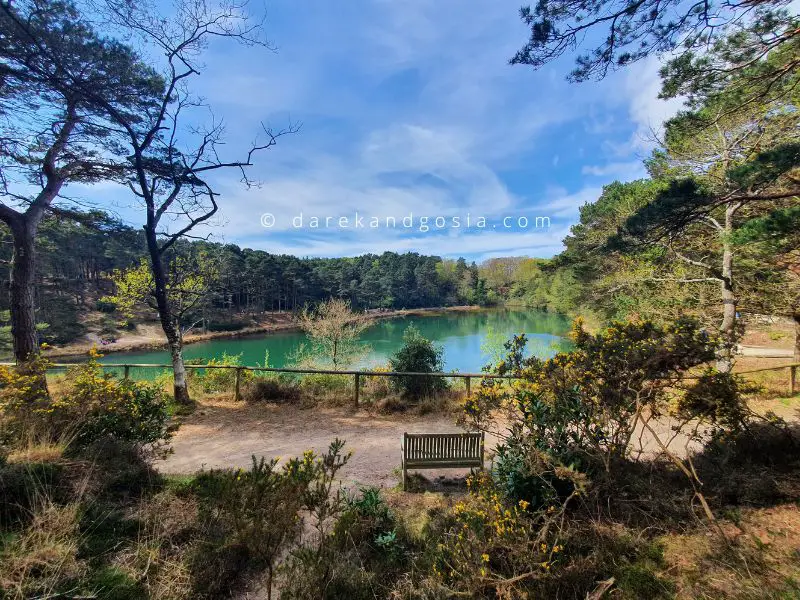
6. Kimmeridge Bay
Things to do Jurassic Coast? Kimmeridge Bay is a bay of the Isle of Purbeck in Dorset, England. It is named after Kimmeridge where it is located. The bay consists of a number of small bays including Kimmeridge Bay, Black Ven and Worbarrow Bay. It has been described as “one of the most important geological sites in Europe” due to its fossils and Jurassic Coast World Heritage Site status as a result.
The area has been popular with residents from nearby towns such as Wareham and Swanage since Victorian times, but even earlier than that it was used for smuggling during the Napoleonic Wars. The area has several caves that were used as hiding places for smugglers’ contraband goods such as brandy, wine and tobacco during this time period.
7. Lulworth Cove
Jurassic Coast places to visit? Lulworth Cove is a beautiful natural bay on the Jurassic Coast in Dorset, England. It is one of the best-known seaside attractions in the county and is visited by thousands of tourists every year.
It is located on the Jurassic Coast, a World Heritage Site, south of Weymouth and north of Swanage. Lulworth Cove’s most prominent feature is its beach, which has been awarded the Blue Flag for cleanliness and safety.
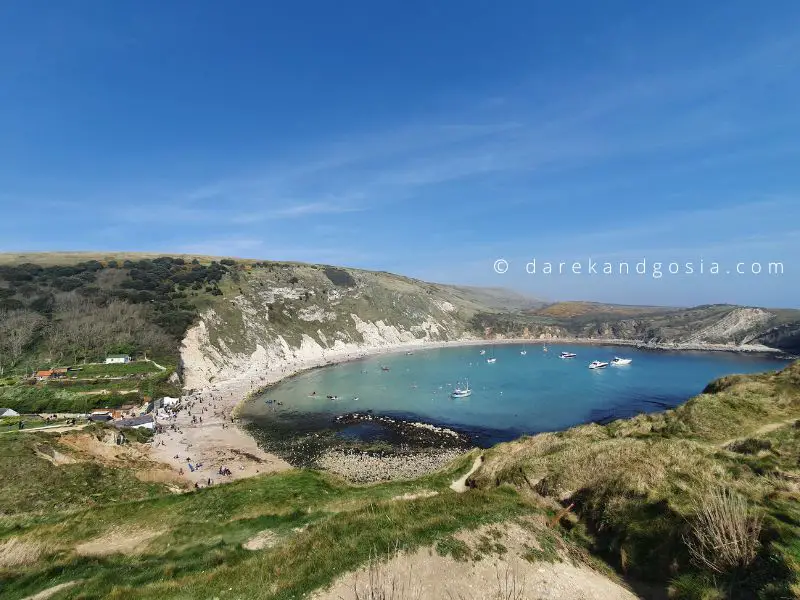
8. Stair Hole
Top Jurassic Coast destinations? Stair Hole is a natural coastal sea cave near Lulworth in Dorset, England. It is a popular tourist attraction and can be reached on foot from the nearby village of Durdle Door. The cave itself is about 100 metres long and up to 15 metres deep. It was formed by wave action on the soft sandstone cliffs of the region about 60 million years ago.
The entrance to Stair Hole is at the bottom of a steep path leading from above. The path winds around the side of the cliff before reaching a tunnel that emerges into a small open area with several benches. From here there is another tunnel which leads to an arched opening at the top of the cliff face which gives access to the caves themselves.
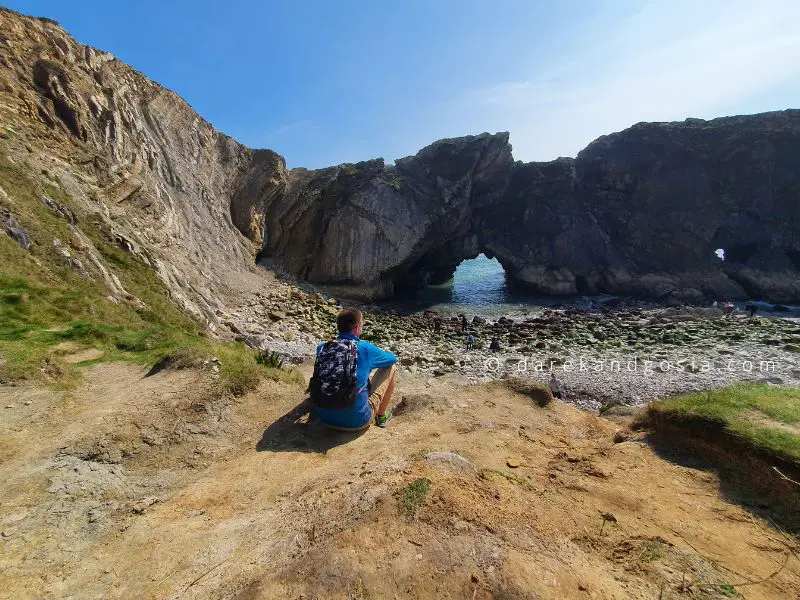
9. West Lulworth
Best days out on the Jurassic Coast? The charming village of West Lulworth lies at the mouth of the River Lulworth where it meets Weymouth Bay. The area is a favourite for walkers, cyclists and birdwatchers who come to see its diverse wildlife in their natural habitat.
There are also plenty of traditional pubs serving local ales and home cooked food along with cafes serving freshly baked cakes, cream teas and hot meals.
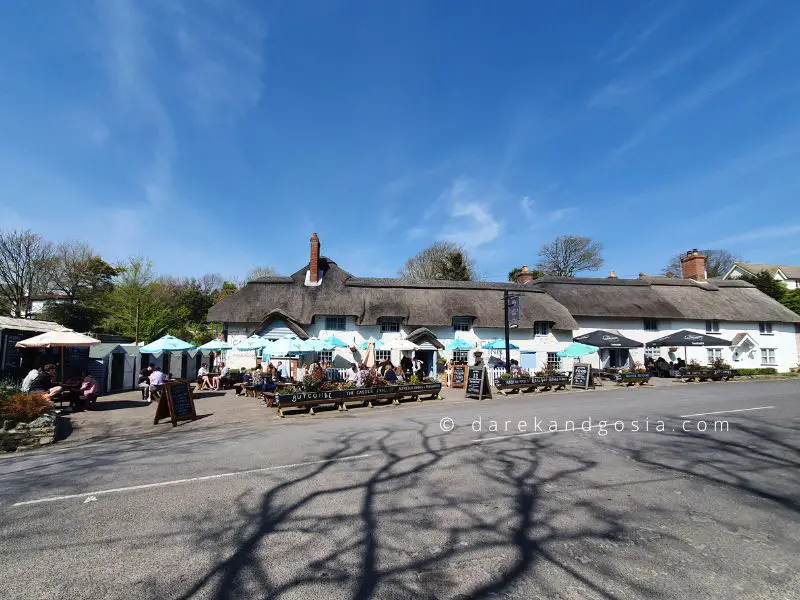
10. Man O’War Beach
Things to do on the Jurassic Coast this weekend? Man O’War Beach is a beautiful beach located on the Jurassic Coast in Dorset, England. The beach is named after the famous Man o’ War racehorse. It is a popular location for surfing and swimming in the summer months.
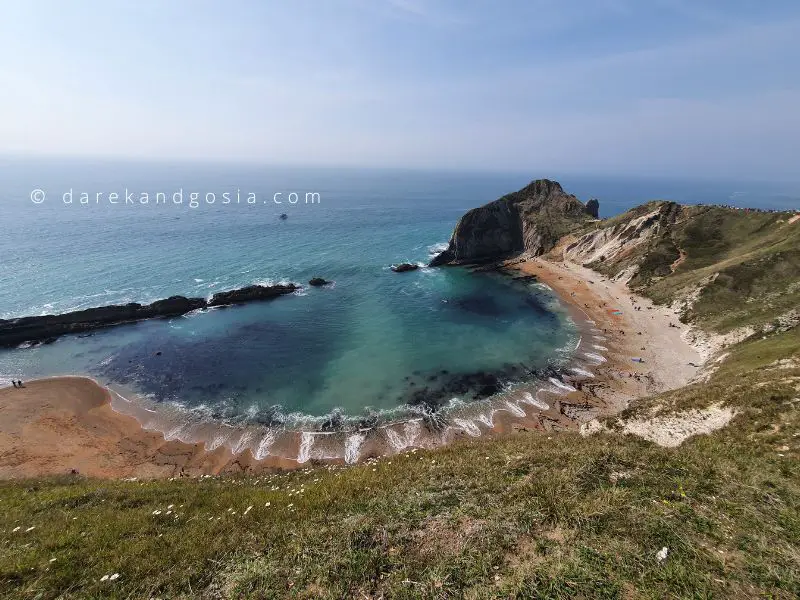
11. Durdle Door
Places to visit Jurassic Coast? Durdle Door is a natural limestone arch on the Jurassic Coast in Dorset, southern England. It is situated near Lulworth Cove, about two miles (3 km) west of Lulworth village.
The arch has been carved by wind and waves over thousands of years. The sea has also eroded the limestone cliffs around it to create the impression of an open mouth, hence its name.
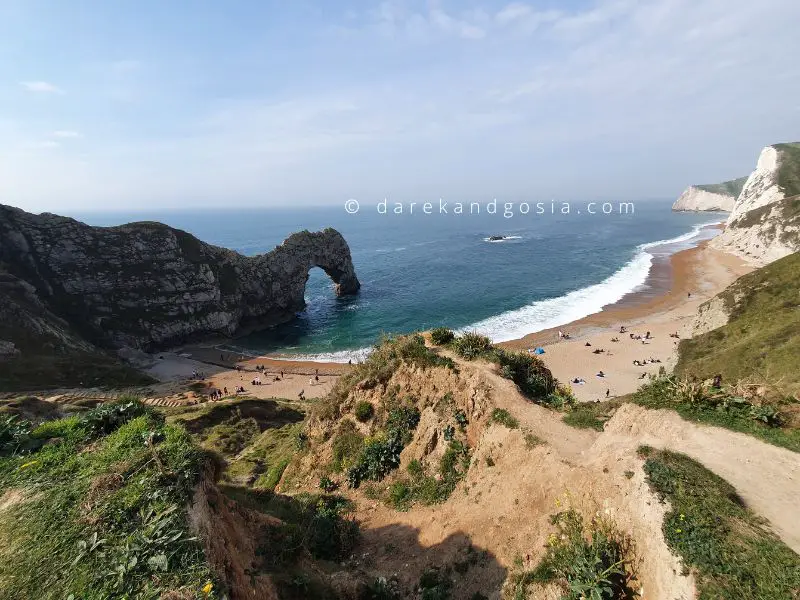
12. South Coast Path
Beautiful places on the Jurassic Coast? The path follows the coast of southern England, passing through some of the most beautiful landscapes in Dorset and Somerset. From Lulworth Cove to Weymouth, you can walk for miles on breathtaking cliffs and sandy beaches, with plenty of places to stop off for refreshments or a bite to eat.
It is 186 miles (300km) long and follows public rights of way along both sides of the coast. If we ask, we are happy to say that the part of the South Coast Path located on the Jurassic Coast is probably the most beautiful!
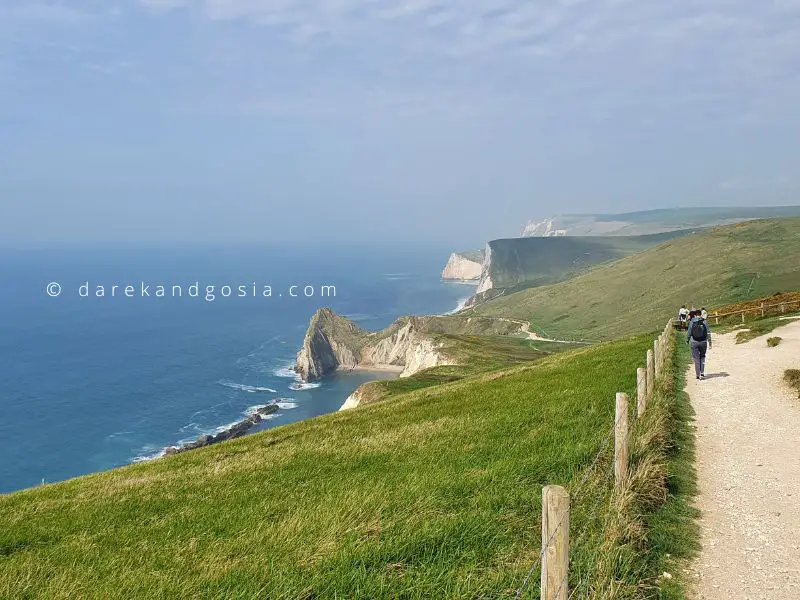
13. Weymouth
Where to go on Jurassic Coast England? Weymouth Dorset is a seaside town in Dorset and the capital of the Purbeck district. It lies on Weymouth Bay, on the English Channel coast, and is a tourist destination with sandy beaches, shops, museums and other attractions.
14. Chesil Beach
Best places to visit on the Jurassic Coast? Chesil Beach is a 3.5 mile stretch of shingle beach on the south coast of England. It lies between the town of West Bay and Portland.
The shingle was deposited at the end of the last Ice Age when melting ice dams caused rivers to flood, depositing sand and gravel across this part of Britain. Over time these deposits have been covered with more layers of shingle to give it its characteristic look today.
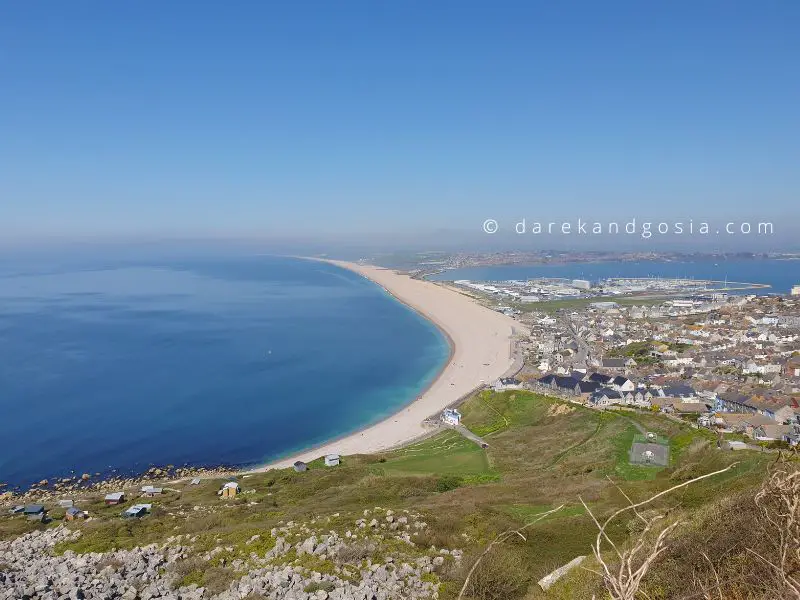
15. Isle of Portland
Where to go on the Jurassic Coast? The Isle of Portland is a limestone tied island located in the English Channel, at the southernmost tip of the Dorset peninsula. It’s easy to get around the island by foot or bicycle, or you can take the bus from Weymouth.
It was once an important British port, but now it’s mainly known as a holiday destination for families. Visit some of the main landmarks – Olympic Rings Stone Sculpture, Pulpit Rock Portland and the stunning Portland Bill Lighthouse!
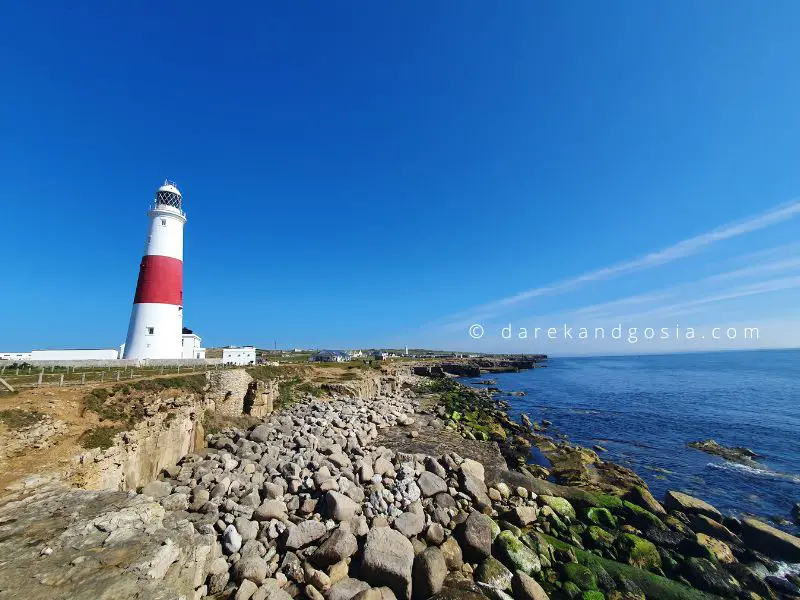
16. Abbotsbury Swannery
Jurassic Coast best places to visit? The Abbotsbury Swannery is a Wildlife Trust nature reserve at Abbotsbury, near Weymouth in Dorset. It is one of the largest collections of captive mute swans in the world, with over 400 birds. The Swans have been residents here for many years and are fed daily by volunteers from the local community.
You can enjoy a guided tour around the water meadows and see these beautiful birds in their natural habitat.
17. West Bay
Top Jurassic Coast tourist attractions? West Bay is a small fishing village situated on the Jurassic Coast in Dorset. The village is famous for its beautiful scenery, with stunning views over Lyme Bay, which is why it’s one of our top places to visit in the South of England.
It’s also known for having some of the best surfing in the country! If you are in the part of the Jurassic Coast then visit the Station Kitchen too – one of the most unique places to eat on the coast!
The town has become a popular tourist destination since the 1960s, and is now one of the most expensive places to buy property on the south coast of England.
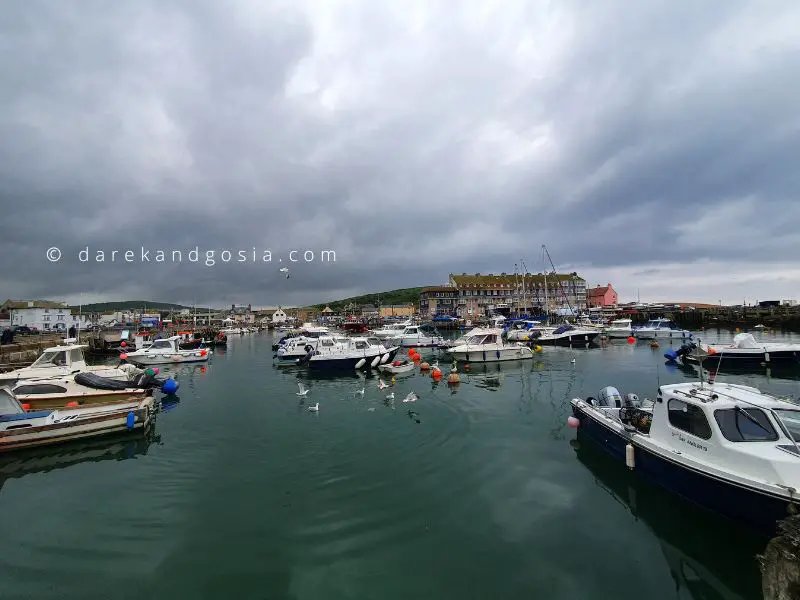
18. Charmouth
Things to see on the Jurassic Coast? Charmouth Dorset is an English seaside village in the county of Dorset. It lies on the Jurassic Coast, a World Heritage Site, east of Bridport, west of Lyme Regis and north of Exmouth. It is a classic seaside village with a long sandy beach and several rock pools which are ideal for children to explore.
Make sure to visit the Charmouth Heritage Coast Centre – it provides information about the geology of the area and has exhibits on local history. The centre also houses an exhibition about Charles Darwin’s work on the Jurassic Coast and displays fossils from the area as well as maps and plans showing how it has changed over time.
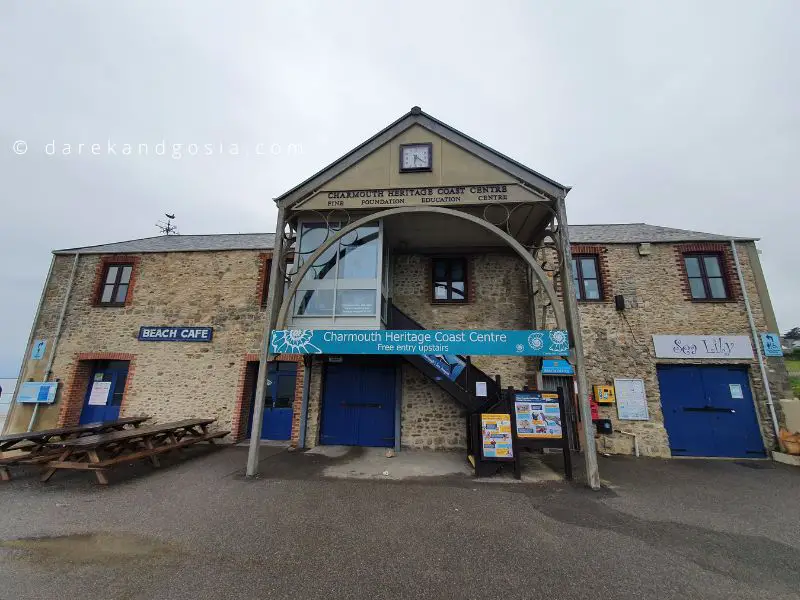
19. Lyme Regis
What to see on the Jurassic Coast? Lyme Regis is a small town in the county of Dorset, on the south coast of England. The town was home to the Old Lyme Regis Museum until it closed in 2012. The town has many attractions for visitors, including two piers, one of which is Grade II listed and has been partially rebuilt after fire damage. It has a population of 5,000 and it’s one of the most beautiful coastal towns near London!
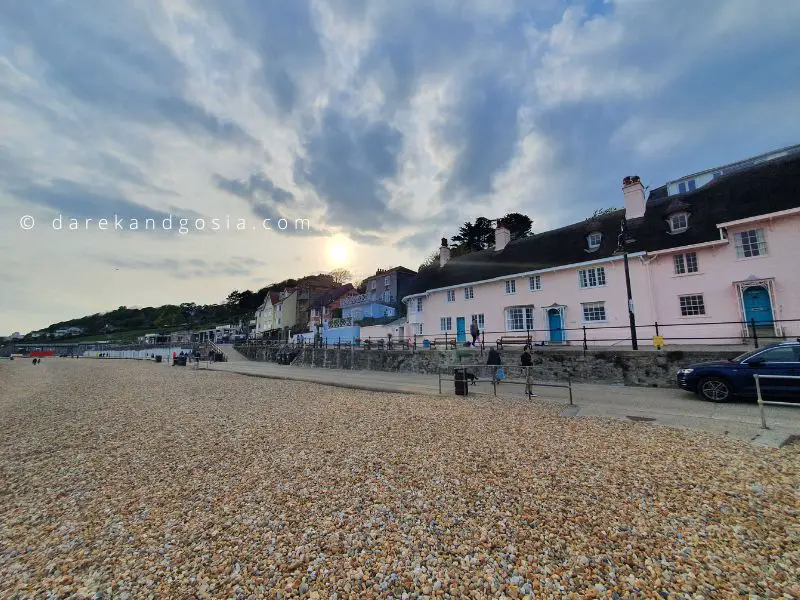
Jurassic Coast places to visit (Devon)
20. Seaton
Things to do in Jurassic Coast? Seaton is a small coastal town in Devon, England. It lies on the River Axe and was formerly a major port. Seaton is situated between Axmouth and Colyton on the B3178 road. It has a population of around 4,500 people, with a further 3,000 people living in surrounding villages.
21. Seaton Tramway
Best things to do in the Jurassic Coast? Seaton Tramway, a narrow gauge railway built in 1867, runs along the beach to Colyford where there is a terminus at Colyford station with two platforms and a passing loop.
The line was originally constructed as a horse-drawn tramway running from Seaton to Colyford via Lower Seaton Farm and Snipe Point. Today, it is one of the best tourist attractions on this part of the Jurassic Coast.
22. Branscombe
Jurassic Coast best places to visit? The village of Branscombe is a small village on the coast in South Devon. It is home to a popular beach and has a population of around 500 residents.
The main attractions of the village are its pubs and restaurants, which serve traditional English food such as fish and chips or roast beef dinners.
23. Branscombe Beach
Jurassic Coast activities to do? Branscombe Beach is a well-known beauty spot, with its clear blue sea and fine golden sands. It is a popular location for surfing and fishing. There are several surf schools operating from this location, as well as kayak hire companies.
The beach itself is separated into two bays by a headland called Branscombe Point. The northern bay has a small shingle beach backed by some rocks, while the southern beach has sand dunes at each end and looks out over Start Bay towards Start Point.
24. The Donkey Sanctuary
Best places Jurassic Coast? The Donkey Sanctuary Devon is a charity based in Devon, England. It is a non-profit making organisation that rescues and rehomes donkeys worldwide.
They provide a safe haven for donkeys in need, supporting them to return to health and rehome them where possible.
If you are interested, you can help us by donating, adopting, fundraising or volunteering at the donkey sanctuary in Devon.
25. Sidmouth
Nice places to visit in Jurassic Coast? Sidmouth is a small seaside town in South Devon, England. Its main tourist attraction is the South West Coast Path which follows the coast from Exmouth to Padstow. It lies at the mouth of the River Sid and its tributary, the River Axe.
It has a population of around 10,500. Sidmouth lies within the South Devon Area of Outstanding Natural Beauty (AONB).
26. Ladram Bay Viewpoint
Top places Jurassic Coast of England? Ladram Bay is a small coastal village in the south west of Devon, England.
The coast around Ladram Bay is popular with walkers, who can enjoy views of Ladram Bay Beach and Ladram Bay. Ladram Bay is a long stretch of sand backed by high cliffs and can be accessed by steps that lead down from the cliffs above. The beach is popular with families and dog walkers who come for the clean white sand and warm water.
27. Otterton
Best places to visit Jurassic Coast? Otterton Devon is a small village in Devon, England. It is located near the southern coast of Devon, between Axmouth and Lyme Regis. The village has a pub, The Rising Sun Inn, which has been open since the 18th century and was voted one of the top 50 pubs in Britain.
The Otterton Brook runs through the middle of the village, providing an excellent habitat for many types of wildlife including otters, kingfishers and dippers.
28. Exmouth
Must-visit on England’s Jurassic Coast? The town of Exmouth is situated on the south coast of Devon. It lies between the mouth of the River Exe and the sea. The town is an important centre for tourism, with attractions including a sandy beach, Exmouth Market and Leisure Centre, the Royal Marines Museum and a wide range of shops and restaurants.
Exmouth has been a tourist destination since the late 18th century when it was developed as a fashionable seaside resort. Its pier has been rated as one of the top 10 piers in the world.
How do I spend a day on the Jurassic Coast?
There are many ways to spend a day on the Jurassic Coast, depending on your interests and how much time you have. Here are some suggestions:
- Visit a beach: The Jurassic Coast is home to many beautiful beaches, including Lyme Regis, Charmouth, and Studland Bay. Spend some time relaxing on the sand, swimming in the sea, or exploring the rock pools.
- Go for a walk: The Jurassic Coast is famous for its stunning coastal walks, which offer breathtaking views of the coastline and the surrounding countryside. Some popular walks include the Golden Cap walk, the South West Coast Path, and the Durdle Door to Lulworth Cove walk.
- Explore a town or village: There are many charming towns and villages along the Jurassic Coast, each with their own unique character and history. Visit places like Lyme Regis, Sidmouth, or Corfe Castle, and wander through the streets, admiring the architecture and exploring the local shops and cafes.
- Visit a museum or visitor center: The Jurassic Coast is a rich source of history and geology, and there are many museums and visitor centers that offer fascinating insights into the region’s past. Visit places like the Lyme Regis Museum, the Charmouth Heritage Coast Centre, or the Etches Collection Museum of Jurassic Marine Life.
- Take a boat trip: One of the best ways to see the Jurassic Coast is from the water. Take a boat trip from places like Weymouth or Swanage, and admire the coastline from a different perspective. You might even spot some dolphins or seals along the way.
- Try some local food: The Jurassic Coast is home to a wealth of delicious local produce, including fresh seafood, locally brewed beer, and award-winning cheeses. Visit a local pub or restaurant and try some of the region’s culinary delights.
Remember to check the weather forecast before you go and dress appropriately for the conditions. Also, be sure to bring plenty of water and snacks, as well as any necessary equipment like hiking boots or swimming gear, depending on your plans for the day.
Jurassic Coast history
The Jurassic Coast is a 95-mile stretch of coastline on the southern coast of England that is known for its rich geological history. The coastline spans from Exmouth in East Devon to Studland Bay in Dorset and has been designated as a UNESCO World Heritage Site due to its importance in understanding the evolution of the Earth’s history.
The Jurassic Coast is named after the Jurassic period, which lasted from around 200 million to 145 million years ago. The region is famous for its unique rock formations, including the distinctive white cliffs of Dorset, which were formed during this period.
Throughout the centuries, the coastline has been used for many different purposes, including fishing, smuggling, and defense. During World War II, the area was heavily fortified to defend against potential German invasion, and many of the bunkers and pillboxes can still be seen today.
The Jurassic Coast has also played an important role in scientific discoveries. In the early 19th century, Mary Anning, a fossil hunter from Lyme Regis, made several important discoveries in the area, including the first complete ichthyosaur skeleton. Her discoveries helped to shape our understanding of prehistoric life and the evolution of the Earth.
Today, the Jurassic Coast is a popular destination for tourists and scientists alike. The area is home to many museums, visitor centers, and geological sites, including the Charmouth Heritage Coast Centre, the Etches Collection Museum of Jurassic Marine Life, and the Lulworth Cove and Durdle Door geological formations. Visitors can explore the unique geology of the region, learn about its history, and enjoy its stunning natural beauty.
Jurassic Coast tourist information
The Jurassic Coast is a popular tourist destination in southern England, known for its stunning coastline, geological features, and historical significance. Here is some tourist information to help plan your visit:
- Best time to visit: The Jurassic Coast can be visited year-round, but the best time to go depends on your interests. The summer months (June-August) are the busiest and offer the warmest weather for swimming and beach activities. Spring (April-May) and autumn (September-October) are less crowded and offer milder weather for walking and sightseeing.
- Getting there: The Jurassic Coast can be reached by car, train, or bus. The closest airports are Exeter, Bournemouth, and Southampton. There are also several train stations along the coast, including Exmouth, Axminster, and Weymouth. Local bus services are available to many of the towns and villages along the coast.
- Things to do: There are many things to do along the Jurassic Coast, including:
- Visit the beaches, such as Lyme Regis, Charmouth, and Studland Bay
- Go for a walk along the South West Coast Path or other coastal trails
- Explore the historical sites, such as Corfe Castle or Portland Bill Lighthouse
- Visit the museums and visitor centers, such as the Charmouth Heritage Coast Centre or the Lyme Regis Museum
- Take a boat trip or go kayaking to see the coast from a different perspective
- Accommodation: There are many accommodation options along the Jurassic Coast, including hotels, B&Bs, holiday parks, and campsites. Popular towns and villages to stay in include Lyme Regis, Sidmouth, Weymouth, and Swanage.
- Food and drink: The Jurassic Coast is known for its fresh seafood, locally brewed beer, and award-winning cheeses. There are many pubs, restaurants, and cafes along the coast offering these and other local specialties.
- Safety: The Jurassic Coast can be dangerous in places, with unstable cliffs, strong currents, and deep water. Visitors should take care when walking, swimming, or exploring the coastline, and follow any warning signs or advice from local authorities.
- Further information: For more information on the Jurassic Coast, visit the official website of the Jurassic Coast Trust, which provides information on attractions, events, and conservation efforts along the coast.
What attracts visitors to Jurassic Coast?
The Jurassic Coast is a popular destination for visitors due to its stunning natural beauty, rich geological history, and cultural significance. Here are some of the main attractions that draw visitors to the area:
- Geological significance: The Jurassic Coast is one of the most important and significant geological sites in the world, containing rocks and fossils that span 185 million years of Earth’s history. Visitors can see a wide range of geological features, including cliffs, rock formations, and fossils.
- Natural beauty: The coast is known for its dramatic cliffs, beaches, coves, and bays, as well as its stunning views of the sea and surrounding countryside. The coastline is also home to a variety of wildlife, including seabirds, seals, and dolphins.
- History and heritage: The Jurassic Coast has a rich cultural history dating back thousands of years, with numerous historical and cultural sites to explore, such as ancient forts, castles, and historic towns and villages.
- Outdoor activities: The area offers a wide range of outdoor activities, including walking, hiking, cycling, fishing, and water sports, making it a popular destination for active visitors.
- Food and drink: The coast is renowned for its fresh seafood and locally sourced produce, with many excellent restaurants and pubs serving up delicious dishes.
- Family-friendly attractions: The Jurassic Coast has many family-friendly attractions, including museums, theme parks, and wildlife centers, making it a great destination for families with children.
What famous film was filmed on the Jurassic Coast?
The Jurassic Coast has been the location for several famous films, including “The French Lieutenant’s Woman” (1981), which starred Meryl Streep and Jeremy Irons, and was based on a novel by John Fowles that was set in Lyme Regis. More recently, the Jurassic Coast was also featured in the blockbuster film “Ammonite” (2020), which starred Kate Winslet and Saoirse Ronan, and was filmed in several locations along the coast. The stunning scenery and unique geological features of the Jurassic Coast have made it a popular location for filmmakers and TV producers.
What to do on the Jurassic Coast in the rain?
While the Jurassic Coast is a beautiful destination, rain is a common occurrence in the area, so it’s important to have some indoor activities planned in case of inclement weather. Here are some things to do on the Jurassic Coast in the rain:
- Visit museums and visitor centers: There are many excellent museums and visitor centers along the Jurassic Coast, which offer fascinating insights into the history, geology, and culture of the area. Some popular options include the Lyme Regis Museum, the Charmouth Heritage Coast Centre, and the Dinosaur Museum in Dorchester.
- Take a cooking class: The Jurassic Coast is renowned for its fresh seafood and locally sourced produce, so why not take a cooking class and learn how to make some delicious dishes using local ingredients?
- Visit a spa: There are many spas and wellness centers along the Jurassic Coast, which offer a range of treatments and therapies to help you relax and unwind.
- Explore historic buildings: The coast is home to many historic buildings and sites, including ancient forts, castles, and stately homes. Many of these are open to the public, offering a glimpse into the area’s rich cultural history.
- Go shopping: There are many charming towns and villages along the coast, which offer a range of independent shops and boutiques selling everything from local crafts to designer fashion.
- Take a scenic drive: If you don’t mind braving the rain, a scenic drive along the coast can be a great way to appreciate the rugged beauty of the area, while staying warm and dry inside your car.
Best places near Jurassic Coast to visit
There are many beautiful and interesting places to visit near the Jurassic Coast. Here are some of the best:
- Durdle Door: Located just a short distance from the Jurassic Coast, this iconic natural arch is one of the most famous landmarks in the area.
- Chesil Beach: This long stretch of shingle beach is a popular spot for fishing, birdwatching, and scenic walks.
- Abbotsbury Swannery: This unique attraction is home to hundreds of swans, and visitors can watch the birds being fed and even hold a cygnet.
- Portland Bill: This rugged headland offers stunning views of the coast, and is home to a working lighthouse and a variety of wildlife.
- Corfe Castle: This historic castle, located in the Purbeck Hills, is over 1,000 years old and is one of the most impressive medieval ruins in England.
- Lulworth Cove: This picturesque cove is surrounded by cliffs and is a popular spot for swimming, kayaking, and snorkeling.
- Bridport: This charming market town is located just a few miles from the coast and is home to a range of independent shops and cafes.
- Sherborne: This historic town is home to several impressive medieval buildings, including a castle and a beautiful abbey.
- New Forest National Park: This beautiful national park is home to a variety of wildlife, including wild ponies, and offers a range of outdoor activities, including hiking, cycling, and horse riding.
- Exeter: This historic city is located just a short distance from the coast and offers a range of attractions, including a beautiful cathedral, a range of museums, and a variety of shops and restaurants.
Is Jurassic Coast worth visiting?
Yes, the Jurassic Coast is definitely worth visiting! It is a beautiful and unique area with stunning coastal scenery and an incredible geological history. The coast offers many different activities, from walking and hiking along the cliffs to exploring the rock pools and beaches, and there are many museums and visitor centers that provide fascinating insights into the history of the area.
The Jurassic Coast is also a designated UNESCO World Heritage Site, which recognizes its outstanding geological importance and global significance. The coast offers visitors a chance to see and learn about geological features that span millions of years of Earth’s history.
In addition to its natural beauty and geological significance, the Jurassic Coast is also steeped in cultural history, with fascinating sites and stories related to smuggling, fishing, and defense dating back centuries.
Overall, the Jurassic Coast is a unique and memorable destination that offers something for everyone, whether you’re interested in history, geology, or simply enjoying the great outdoors.
Articles you may like:
